”The
Almond Family” or Almond (St);
Qualmond (StQ);
Faded (StF);
Hickory(StH);
Sandy(StSa);
Chalky (StC):and
Frosty(StFr)
I personally don't have Almonds nor have I bread any in the past. What
little I do know about them I gleamed from Dr. Willard F Hollander, Dr.
Lester Paul Gibson, Dr. Axel Sell, Dr. Randal Herring, Joe Quinn, Ken
Davis, Frank Mosca and Tom Barnhart. I do however have some Qualmonds
and their photos are included below along with some of Tom Barnhart's
Almonds. I hope this all makes sense and gives a clearer picture of
this family or series of gene alleles. Ya I know, the Almond Family
sounds like some kind of a country music album but in this case, its
more like their flashy clothes than their music.
Almond (St),
a sex linked dominant, with it's speckled variegated color pattern is
believed to be the oldest mutation in this series of gene alleles
(group of alternative genes). This series or family group of alleles
gene mutations, all occur at the same locus or location on the sex (Z)
chromosome. In other words, they are all multiple alleles or
alternatives for the wild type gene they would displace. Since this
particular group is a part of the sex chromosome they are sex linked.
Their genetic effect is to lighten the base color by randomly
inhibiting the formation of pigmentation during new feather growth.
This is what causes the random flecking to occur. The amount of
flecking varies and tends to increase with each molt. Most birds will
darken each year until they are nearly back to their normal base color.
Dr. Willard F Hollander, in his book "Origins and Excursions in Pigeon
Genetics gives an excellent recap of the history of Almond. Most of the
information here was taken from his book. He writes that Almond gets
its genetic symbol (St)
from Wriedt and Christie for the German word
“gesprenkelt” which is the German description for
variegation and the Danish words “Stipper” and
“Stankede” which translates to mean speckled. Be it
German or Danish both have similar meanings to describe this wonderful
color combination. Where this mutation originated at first is not known
for certain. Dr. Hollander believes it to have been Persia with
Oriental Rollers. John Moore described it in England in 1735 but its
origin is really much early. It was Wriedt and Christie who in 1925
conducted the first known genetic studies on this mutation. They
reported that Almond was a sex linked dominant. In addition, their
squabs had shorter down than normal, similar to Dilute (d)
squabs. Keep in mind that while Dilute and Almond are both sex linked,
Almond is a dominant and Dilute a recessive phenotype.
A classic Almond phenotype is a
scrambled patchwork of yellowish, blue, black, brown, red, and whitish
colors. Not all of these patchy colors are the direct result of the
Almond gene but rather results when combining Almond with recessive red
(e),
kite bronze (K)
and sometimes dilute (d)
to produce these colorful phenotypes.
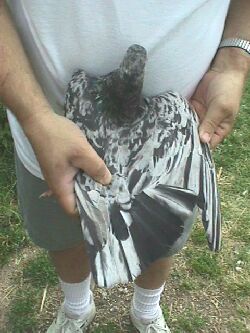 .
.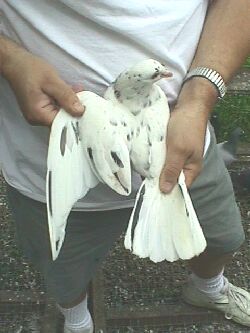 .
.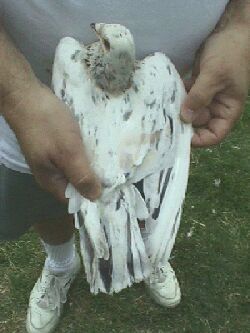
A plain Almond, like the one Tom
Barnhart is holding for my camera above on the right, is not all that
attractive. It has the flecking, is much lighter or whitish in base
color but it lacks the full color contras that's provided by the other
modifiers in producing the desired colors with enhanced amounts of
color break. Classic Almond is best expresses on a T-pattern (CT)
like the one Tom is holding (upper left). T-pattern provides the best
base for the almond flecking effect. A double dose of Kite (K)/
(K)
and a single dose of recessive red (e)
adds to its color richness and depth. Axel Sell in his book
“Breeding and Inheritance in pigeons” gives the
following recipe for success in breeding classic almonds. Sell suggests
that cock birds be (St)/(+);
(CT)/(CT);
(e)/(+);
(K)/(K).
He also suggest the addition of dilute (d)/(d).
Hens would be similar but can only carry a single factor for dilute due
to the sex linkage involved.
Joe Quinn in The Pigeon Breeder's
Notebook: An Introduction to Pigeon Science goes into detail to
describe the breeding of Almonds. He brakes it down step by step and
explains the what and why of the process.
The possibilities for different
phenotypes is endless when you consider all the other modifiers that
can be combined with this recipe. Some might even improve the classic
form while others may not. Many have yet to be tried, so your guess, as
to what could result, is as good as anyone’s .
With all its beauty, the breeding of
good Almonds is not without problems. Males which are pure for this
gene are prone to die while still in the nest. Those that do survive
are mostly white with, poor eye sight, bladder eye and or blindness.
For these reasons breeding Almond to Almond is not recommended.
Remember you only want a single factor for both Almond and recessive
red. That being the case, you can’t fix the gene pool once
you have the right combinations and expect it to stay that way. Both
the almond and the recessive red will double up in future generations
and take over the phenotype. What you get are more recessive red
almonds known as DeRoys with the almond's eye problems. The secrete to
success is to continually mate your Almond birds with non Almond birds
of the desired gene combinations (CT)
and (K).
Only then will you continue the desired effects.
But wait a minute, what are DeRoys? Well DeRoys are recessive red
almonds like I said above. The good ones will only carry one gene for
almond. Ken Davis described them in a post to the pigeon genetics yahoo
group. Basically Ken said….. “A DeRoy's color is,
sort'a gold colored. A color in-between recessive red and recessive
yellow, with many different shades, depending upon the genetic
complement of the individual. Most often, as these recessive red
almonds (DeRoy's) age, they get "break" or "flecking" just like
'classic almonds' do, only the break or flecking is dark recessive red
in color.…………Recessive red
does not completely cover up or Mask/Hide almond. The two mutants each
express together to create this "DeRoy" coloration, which is incomplete
dominance of the almond mutant, and incomplete epistasis of the
homozygous recessive red mutant.” …….K
& A Davis.
It should be noted here that some ash red birds will also be heavily
flecked and appear to be Almond. A good example is this heterozygous
ash red and blue/black, homozygous dilute t-pattern cock shown below.
He does look very similar to Almond but his dilute ash yellow color
with the typical type flecking that will occur in this combination is
different. The base color of the bird is not lightened nor changed. It
is just heavily flecked dun on yellow. The diluted ash color is still
diluted ash. The dun color of the flecking is still dun. This bird's
overall colors will not darken with age. You can have a similar effect
with some spread ash cocks that are also heterozygous ash red and
blue/black. Almond on the other hand turns the formation of pigment on
and off at random as the feather grows. This effect lessens the amount
of pigment in the ground color and cause it to come together in
splotches and or large flecks. This flecking becomes much more
prevalent with age, which in turn darkens the birds overall color.
I'm not sure what the cock bird below
on the right is. He should be a heterozygous ash red and black grizzle.
He's the product of a homozygous blue/black grizzle and a ash red bar
hen. His color is white with heavy black flecking that has increased
with age. Neither of his parents are heavily flicked nor are any of his
young. I test matted him to a blue bar hen and produced two
heterozygous ash red /blue black grizzle cocks. Neither youngster looks
like him. They each show ash red in their bars and neck. He does not
show any bars nor any ash red color. As a heterozygous grizzle he
should. For that reason, I'm not sure what all he is. Any suggestions?
 .
.
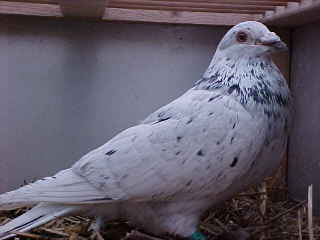
OK that’s a start on the description of Almond but what about
the others in this grouping? Well basically they differ from each other
in the amount of change they produce from the wild type. By now you
should know the wild type to be a blue bar phenotype. Almond (St)
produces the greatest amount of change for color break flecking and the
most amount of color contrast within this genetic grouping. The others
are each a little less drastic in change from the wild type, until you
finally are back to the original form or wild type.
Faded (StF)
is a mutation that was first noticed by Dr. H.W. Feldman at the
University of Michigan in 1933. Dr. Feldman knew through test mating
that this bird was not an Almond even though it was produced from an
Almond hen and a Kite cock. Instead of the Almond effect, the bird was
more of a washed out Kite in color. He passed all the birds he had
produced on to Dr. Hollander who conducted more studies and eventually
identified it as being Faded (StF).
In the process, it was given other names and genetic symbols
[Feldman’s opal (Of)
and later because it was thought to be an alleles of brown (BOf)].
As more data was collected these names and symbols were again changed
in 1951 to reflect what it’s called today. Since the
homozygous or pure Faded cocks did not have any of the mortality
weakness nor eye problems that were found in pure Almond cocks, Dr.
Hollander saw the possibility of using this gene for auto-sex
identification in the nest. In fact, some breeders do refer to it as
Auto-Sex. The breed Texan Pioneers is an example of this pure form of
Faded. It was introduced in that breed for the auto-sexing purpose.
Heterozygous Faded males are like the
one found by Feldman in that they are partly faded or bleached out from
their normal base color and display very little if any flecking. The
hemizygous faded female is nearly normal to partly faded, also without
the flecking effect and appear similar to the heterozygous Faded cocks
even though they (the hens) are also pure for the gene. Since a hen can
only carry one factor, it’s genetic effect is not compounded
as it is in the pure homozygous cocks. These pure cocks are whitish
with a slight sandy effect in their tail band, ends of the flights and
neck. There can be traces of reddish in the neck and sometimes in the
wings. Some may have faded base colored flecks scattered in their
plumage, especially around the hackle (neck). When they do, they will
look very similar to Almond.
My friend Anton Carro Garrote of
Spain has given me permission to post his faded pigeon photos taken
from his web site at
http://palomasmensajerasdecolor.spaces.live.com/
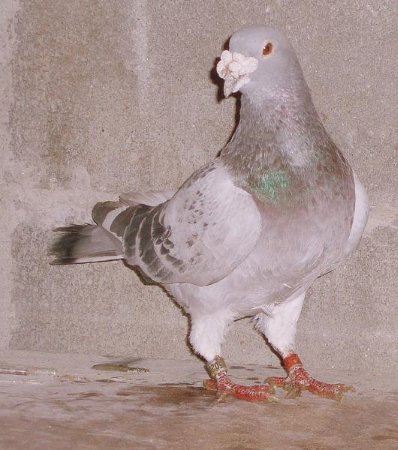
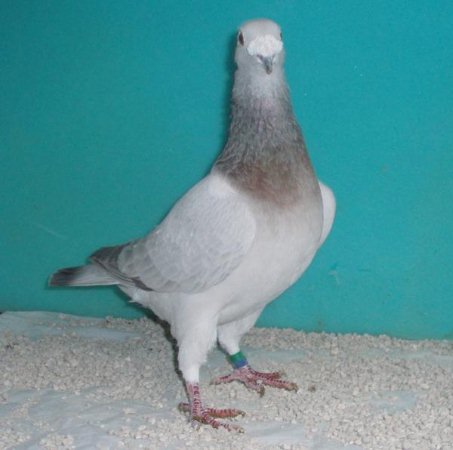
Heterozygous faded blue check cock on
the left, heterozygous faded blue bar on right.
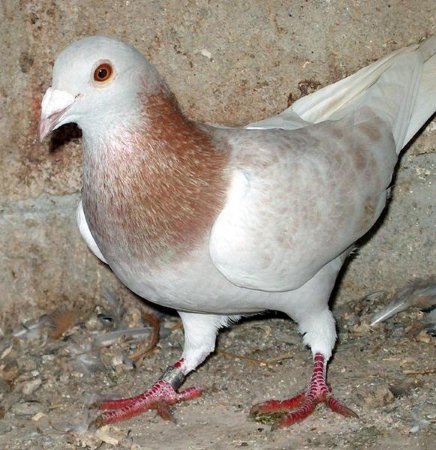
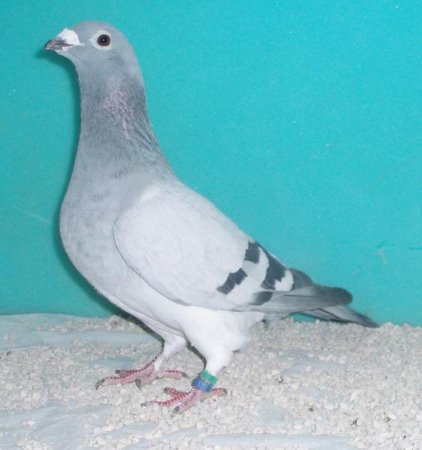
Heterozygous faded ash red check cock
on the left, hemizygous faded blue bar hen on right.
Qualmond (StQ)
is more gray like in appearance but retains the characteristics for
break or flecking which also increases with age. This flecking however
is not as thick as that found on either Almond or Hickory.
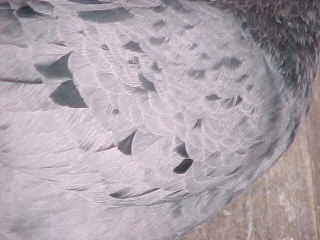
Like Faded, homozygous Qualmond cocks
do not have the mortality nor eye problems that are so common in
homozygous Almonds. Therefore, the breeding of Qualmond to Qualmond can
be done without any ill effects. Like both Almond and Faded, the
homozygous cocks are much lighter than their hemizygous sisters or
heterozygous male cousins.
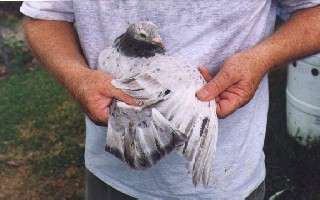 .
.
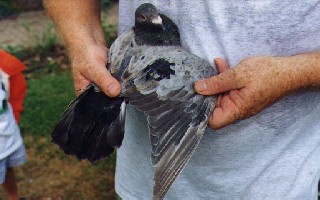
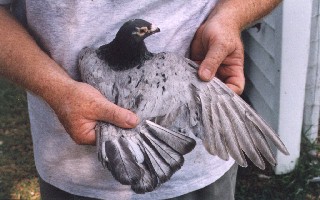 .
.
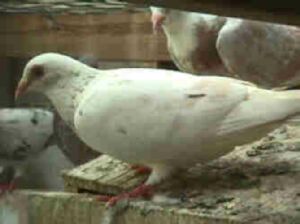
 .
.
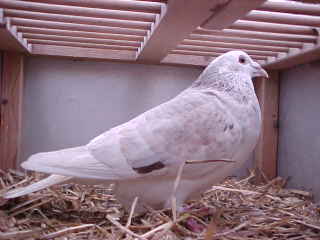 .
.
This mutant was first noted by Joe Quinn on a feral pigeon in Ohio. He
conducted all the required genetic tests to demonstrate that it is was
an alleles for Almond. The name Qualmond is derived from the term
Quinn’s Almond. In other words, Qualmond is named in honor of
Joe Quinn by his many admirers and not as a description of its
phenotype as are the other alleles genes for this chromosome locus.
I have some Qualmonds in my loft and
enjoy them very much. Its amazing to me to watch their transformation
takes place in the first molt. The ones shown below are all about two
years old. I guess I need to photograph a bird before and after its
first molt to show the progression through to the two year state.
Hickory (StH):
was first identified by John Potter in Michigan. Unlike Faded and
Qualmond, Hickory does have the same eye defects as Almond. Hickory is
very similar in appearance to Almond. It is the tail that you look to
in differentiating Hickory from Almond. Here the tail is only slightly
effected by flecking and the bar shows normal.
Sandy (Stsa)
as reported by Dr.Hollander has very little flecking. In addition the
flecking does not darken or increase with age.
Chalky (StC):
is being researched by Robert Mangile. He refers to it as either Orange
or Chalky. Dr. Paul Gibson in his Genetics of Pigeons Columba livia
(Gmelin) reports “It seems that it affects the primary colors
to different degrees producing chalky blue, orangish ash reds, and
chalky browns.” Other than this there doesn’t seem
to be much reported on Chalky.
Frosty (StFr):
is the last in this series. With Frosty only the cocks show some
mutation effect while the hens remain unchanged. It is being studied by
Tim Kvidera. However I must again turn to Dr. Gibson for information.
He reports Frosty to be “a recessive sex-linked gene that
phenotypically only expresses on the cocks with the females appearing
nearly normal. Hemizygous hens and heterozygous males tend to show a
slight lightening of the flights and rectrices near the
shafts.” Like Chalky there doesn’t seem to be much
reported on it.
There is one more which is thought to
also be a member of this grouping. I don’t know what its
called. All I know, is that Dr. Gibson reports it has been isolated by
Mich Leahy of Australia and is currently being researched there. If
anyone has additional information on Mich’s findings, please
pass them along to me and I’ll include them here.
Well there you have it. The complete
grouping as I was able to dig up from the big guns in genetics. I guess
you could say that these family members are a gradual change from
Almond back to the wild type or gradual mutation back to what would be
their normal color. At times, it is hard to tell where one form stops
and another begins.
This gene grouping seems to be
unstable. It seems to mutate from one form to another and back again. I
guess the real question here should be “Are all these really
more than one gene or are some of these possibilities, the result of
other modifiers effecting the phenotype?“ The answer to this
question has not been totally resolved. To answer it based solely on a
gut feeling would be wrong. I think Joe Quinn is correct when he told
me, at the 2000 APFC meeting in Oklahoma City, that some of these
mutants still need to be clearly demonstrated through more genetic
testing. Only then should we assign them a gene classification. I think
he summed it up this way, “When did we start determining fact
by popular vote”? As always, Joe cuts right to the heart of
it. His genetic books and other writings are all well founded on
demonstrable facts.
Today, you can’t speak
about Almond without also speaking of Ken Davis. Ken writes an
excellent column in the Pigeon Debut titled
“Almondated” where he answers the many questions on
Almond breeding. Ken has a BS in Animal Science and uses his column to
explain this wonderful color we call Almond. If you want a real
challenge and are interested in this coloration, I suggest you include
Ken’s writings in your course of study along with the others
referenced above. Whether its a thrill of breeding beautiful birds or
studying genetics, this gene grouping has all the trappings to wet your
whistle. Just spend five minutes talking with Joe Quinn or Ken Davis
and you'll see what I mean.
Well there you have it. That's the
extent of what I was able to learn about Almond and it's many alleles.
Like I said at the start, I don't breed Almonds and I am not an expert
on how to get more out of them. I hope this will help you to understand
more about this grouping.
I always like to put a face to
peoples names I read about. I'm sure you feel the same way. I had the
unique pleasure and once of a lifetime opportunity to meet several of
these for the first time while attending the American Pigeon Fanciers
Council (APFC) meeting this year (2000) at Oklahoma City. Here are some
of the photos I took.
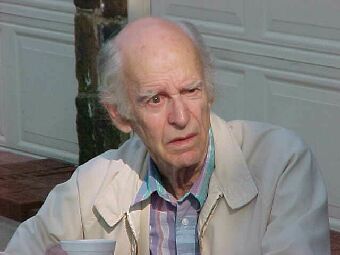
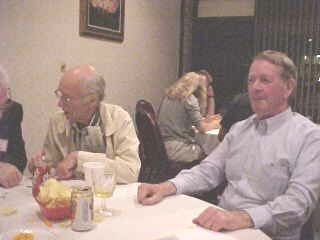
Dr. Hollander left; Dr. Hollander and
Joe Quinn on the right
 .
. 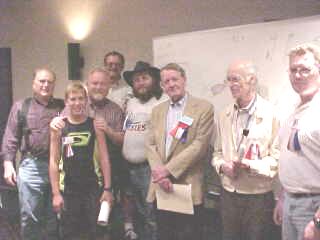
Johnnie Blaine on the left. On the
right is a photo of the Genetic Group at the APFC. They are from left
to right Ramon Kinkade, Michael Bingham, Ronald Huntley (me), Johnnie
Blaine, some guy with a hat, Joe Quinn, Dr. Hollander and
R. Joel Kinkade.
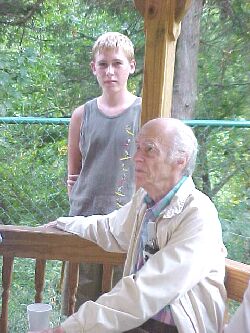 .
.
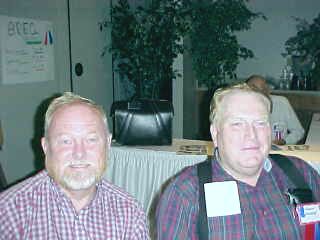
Dr. Hollander and my grandson Michael
Bingham on the left. On the right is my friend Ramon Kinkade and me
with the beard.

Ken Davis with a big smile.
Next Page - Opals
Back To Start Page
Copyright 1999 by Ronald Huntley.
Permission is granted to download or copy for non-commercial individual
use only.
The author retains all other rights under copyright.
Ronald
R. Huntley
Web Page Designer
Duncan SC 29334
phone: (864) 249-0276